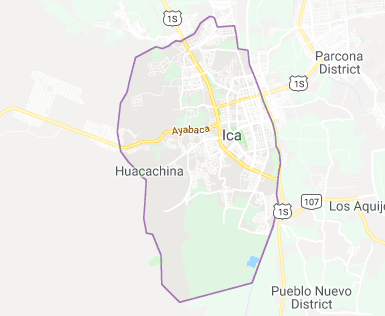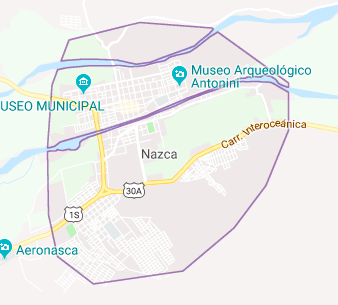Paracas, Peru, as well as Ica and Nazca, might not be at the top of your travel list when thinking about going to South America based on all of the other sites to experience. Based on our experience, we recommend that you take the time to look into Paracas, Ica, and Nazca because we think you will enjoy your time there.
The actual town of Paracas, Peru is nothing more than a small boardwalk with touristy seafood restaurants, souvenir shops, tour companies and a harbor full of fishing boats. The Paracas beach is small and the water is not crystal clear as the entire seafront is lined with fishing boats.
However, after having spent the last few months chock-full of excursions, hiking up mountains in San Pedro de Atacama and Days Trips from Cusco, and seeing one of the most popular Easter traditions in South America in Ayacucho, it was so nice to spend two weeks swinging in a hammock, swimming in a pool at our Airbnb, and chilling in this tiny, laid-back, beach town that is Paracas.
Don’t let me fool you…we did get adventurous and rented some dune buggies and explored the Paracas National Reserve. Here we stopped at Supay beach and saw the famous Cathedral rock formation and we made a quick stop at Playa Roja (Red Beach) to watch the sunset.
https://youtu.be/J3VCe8xtrEA
Fun fact…with just a few days of no wind at all, kite flying wind averaging 20 knots in the afternoons, Paracas has some of the best kitesurfing in South America!
Day Trip to Ica and Nazca
Prior to leaving Paracas, Peru, we booked three additional tours, a pisco and wine tour in Ica followed by a sand dune buggy and sandboarding excursion and a Cessna flight tour to view the Nazca lines in Nazca.

In Ica we visited 3 different wineries where we learned how pisco and wine are made and we were able to taste approximately 10 different types of pisco! At the end of the tour, we took a sand dune buggy in the desert for an adrenaline, rush. Don’t worry…we did not drive after a morning of drinking wine and pisco.
The tour we chose provided a highly skilled driver that knew exactly how to drive (or should I say fly?) through the desert dunes at high speeds all the while he made sure our vehicle did not roll or flip over while he did not wear shoes! The tour itself took one full day.
The Nazca lines are large geoglyphs that are spread across more than 80 km (50 mi) of desert land between Nazca and Palpa. There are hundreds of geometric lines and shapes and over 70 zoomorphic animals. Researchers believe that the Nazca culture created these lines between 500 BCE and 500 CE.
On the ground, the lines appear to be hills that are part of the natural landscape. From above (aerial view), one can see the colossal, stunning images created many many years ago including a hummingbird, monkey, spider, lizard, condor, and flamingo. Scientists have speculated both about how the lines were made and what the purpose of the Nazca lines are.
Some scientists believe that small teams of Nazca people could have dug the lines without aerial assistance and primitive tools in just a couple of days. The lines themselves are just 10-15 cm deep ( 4-6 in) and with the perfect combination of dry, hot, still air, the lines would remain uncovered and visible. There are several theories behind why the Nazca lines were made.
Some believe the Nazca created the lines so they could be seen by their gods in the sky. Others believe that figures represented constellations while others believed that the figures were part of religious practices involving the worship of gods associated with water.
Our aerial tour consisted of a 50-minute flight in a 4 seater Cessna (4 passengers, a pilot, and co-pilot). The day was perfect, sunny, not a cloud in the sky. As our plane took off and gained altitude, the tiny little town of Nazca and the buildings that surround the modern-day town became tiny little specks far below us.
Our co-pilot spoke through his headset about the Nazca lines and their history which transmitted through our headsets as we each listened intently on every word while our faces were glued to our tiny little window trying to take in everything down below. Our co-pilot would say, “on the right you see…” and the pilot would expertly bank the plant to the right angling the plane closer towards the lines for the most perfect view.
Throughout the flight, the images on the earth below were both impressive and massive, a testament to the ancient Nazca people’s ability to create such wonderment with primitive tools without aerial assistance.
Tips: We booked our Nazca line aerial tour in Paracas through a tour agency in Paracas. Our Cessna flights were $85 USD per person. This included transportation to and from our hotel to the Maria Reiche Airport. Once at the airport there is an additional airport tax that you must pay that is $10 USD per person. If you wait and purchase a flight at Maria Reiche Airport it will cost $215+ USD per person for a 50-minute tour.
To get from Paracas to Ica we took a bus on Cruz del Sur. The trip itself took 1 hour and 15 minutes and cost ($12.90 USD/ person). The morning of the flight it is best to eat a light breakfast so as to not risk having an upset stomach on the flight. The plane is a small plane and during the flight, there are many times when the pilot will turn the plane on its side so the passengers will have a better view of the lines below. Having said this, it you are one to get motion sickness, it may be best to use your preferred method of prevention.
If you plan to take a sand dune buggy…prepare yourself for an adrenaline rush! Your driver will take you along with your other passengers into the desert for either a 1 or 2-hour ride up and down the sand dunes. Imagine roller coaster ride minus the track, same thrill, excitement, and suspense; up the dune, wind, and sand slapping you in the face, your climb eventually starts to slow as you reach the brink of the dune, you feel the force of gravity pulling on your body and the flip of your stomach as you go down the dune.
You can hear ear-piercing screams from the passengers aboard rip through the air, adrenaline full force through your veins. The experience is nothing like I have ever experienced before! We were also given a brief lesson on how to sandboard. Unlike traditional snowboarding in which a person stands upright, for beginners, you will learn how to sandboard while lying on your stomach and/or sitting on your bum! Caution…make sure you do NOT move when going down the dunes! You may end up eating sand!
Traveled Late April and Early May 2017




Leave a Reply